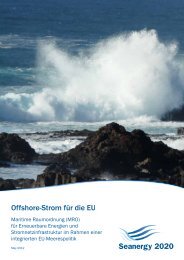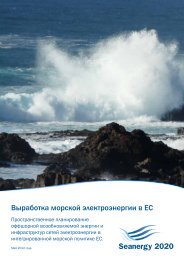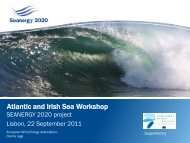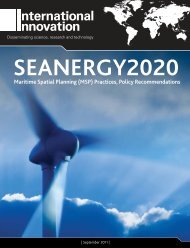Comparative analysis of Maritime Spatial Planning ... - Seanergy 2020
Comparative analysis of Maritime Spatial Planning ... - Seanergy 2020
Comparative analysis of Maritime Spatial Planning ... - Seanergy 2020
You also want an ePaper? Increase the reach of your titles
YUMPU automatically turns print PDFs into web optimized ePapers that Google loves.
Germany that participates also through representatives from the regions which are adjacent to the BalticSea Region (Lander in Germany, Oblasts and Republics in Russia). VASAB 2010 promotes a physicalplanning perspective in the area <strong>of</strong> the Baltic Sea and proposes guidelines and recommendations for workon greater international consensus and has produced “Common Recommendations for <strong>Spatial</strong> <strong>Planning</strong> <strong>of</strong>the Coastal Zone in the Baltic Sea Region”. As the name <strong>of</strong> this document implies, though, it is not bindingin nature.To this end a number <strong>of</strong> existing EU mechanisms for transboundary cooperation in terms <strong>of</strong> planning theuse <strong>of</strong> natural resources may provide useful models including the river basin management planningmechanisms for international river basins foreseen by the Water Framework Directive (WFD) and the jointsea basin planning and coordination measures foreseen by the Marine Strategy Framework Directive(MSFD). Other relevant experience may be derived from the Espoo Convention 20 as well as provisionsrelating to transboundary activities in the SEA Directive as already mentioned and the EIA Directive interms <strong>of</strong> the environmental implications <strong>of</strong> MSP. It is important to emphasize though that MSP evidentlygoes beyond an assessment <strong>of</strong> potential environmental impacts alone.To be effective transboundary consultation and coordination procedures would need to be mandatory andimplemented through appropriate mechanisms for joint decision-making and conflict resolution. The issueas to whether or not the EU has the necessary legal competence to adopt such legislation, though, isbeyond the scope <strong>of</strong> this report.Similarly as regards transboundary cooperation and coordination across sub-national boundaries,appropriate legislation and related mechanisms will be necessary for effective implementation. In thisconnection it may well be the case that if formal MSP is introduced on the basis <strong>of</strong> specific maritime MSPlegislation as in the UK (as opposed to a modification to land use planning legislation as in Germany) animportant administrative boundary may in practice be that between land-use planning and MSP. Againsome form <strong>of</strong> coordination mechanism will be necessary, possibly within the context <strong>of</strong> Integrated CoastalZone Management.7.2 RecommendationsUse the SEA Directive to ensure transboundary consultation where there are likely to beenvironmental impacts on another Member State and build on the joint sea-basin planning andcoordination measures foreseen in the MSFD;Draw on experience <strong>of</strong> other EU mechanisms for transboundary cooperation such as the WFD aswell as the Espoo Convention;20 The Convention on Environmental Impact Assessment in a Transboundary Context adopted at Espoo on 25 February199130 ILM (1991).Deliverable 2.341 | P a g e






